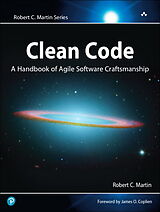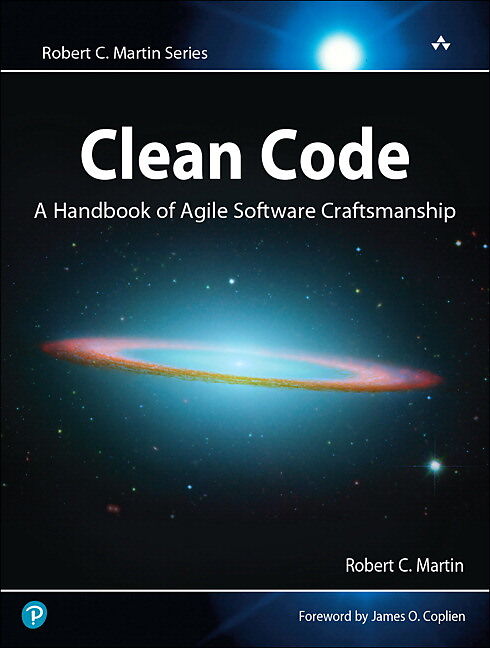Clean Code: A Handbook of Agile Software Craftsmanship
Einband:
Kartonierter Einband
EAN:
9780132350884
Untertitel:
A Handbook of Agile Software Craftsmanship
Genre:
Informatik
Autor:
Robert Martin
Herausgeber:
Pearson Academic
Auflage:
17th print.
Anzahl Seiten:
464
Erscheinungsdatum:
14.08.2008
ISBN:
978-0-13-235088-4
Even bad code can function. But if code isn't clean, it can bring a development organisation to its knees. Every year, countless hours and significant resources are lost because of poorly written code. But it doesn't have to be that way. Noted software expert Robert C. Martin presents a revolutionary paradigm with Clean Code: A Handbook of Agile Software Craftsmanship . Martin has teamed up with his colleagues from Object Mentor to distil their best agile practice of cleaning code on the fly into a book that will instil within you the values of a software craftsman and make you a better programmerbut only if you work at it. What kind of work will you be doing? You'll be reading codelots of code. And you will be challenged to think about what's right about that code, and what's wrong with it. More importantly, you will be challenged to reassess your professional values and your commitment to your craft. Clean Code is divided into three parts. The first describes the principles, patterns, and practices of writing clean code. The second part consists of several case studies of increasing complexity. Each case study is an exercise in cleaning up codeof transforming a code base that has some problems into one that is sound and efficient. The third part is the payoff: a single chapter containing a list of heuristics and smells gathered while creating the case studies. The result is a knowledge base that describes the way we think when we write, read, and clean code. Readers will come away from this book understanding How to tell the difference between good and bad code How to write good code and how to transform bad code into good code How to create good names, good functions, good objects, and good classes How to format code for maximum readability How to implement complete error handling without obscuring code logic How to unit test and practice test-driven development
Autorentext
Robert C. "Uncle Bob" Martin has been a software professional since 1970 and an international software consultant since 1990. He is founder and president of Object Mentor, Inc., a team of experienced consultants who mentor their clients worldwide in the fields of C++, Java, C#, Ruby, OO, Design Patterns, UML, Agile Methodologies, and eXtreme programming.
Zusammenfassung
Even bad code can function. But if code isn’t clean, it can bring a development organization to its knees. Every year, countless hours and significant resources are lost because of poorly written code. But it doesn’t have to be that way.
Noted software expert Robert C. Martin presents a revolutionary paradigm with Clean Code: A Handbook of Agile Software Craftsmanship. Martin has teamed up with his colleagues from Object Mentor to distill their best agile practice of cleaning code “on the fly” into a book that will instill within you the values of a software craftsman and make you a better programmer—but only if you work at it.
What kind of work will you be doing? You’ll be reading code—lots of code. And you will be challenged to think about what’s right about that code, and what’s wrong with it. More importantly, you will be challenged to reassess your professional values and your commitment to your craft.
Clean Code is divided into three parts. The first describes the principles, patterns, and practices of writing clean code. The second part consists of several case studies of increasing complexity. Each case study is an exercise in cleaning up code—of transforming a code base that has some problems into one that is sound and efficient. The third part is the payoff: a single chapter containing a list of heuristics and “smells” gathered while creating the case studies. The result is a knowledge base that describes the way we think when we write, read, and clean code.
Readers will come away from this book understanding
How to tell the difference between good and bad codeHow to write good code and how to transform bad code into good codeHow to create good names, good functions, good objects, and good classesHow to format code for maximum readabilityHow to implement complete error handling without obscuring code logicHow to unit test and practice test-driven developmentThis book is a must for any developer, software engineer, project manager, team lead, or systems analyst with an interest in producing better code.
Inhalt
Foreword xix
Introduction xxv
On the Cover xxix
Chapter 1: Clean Code 1
There Will Be Code 2
Bad Code 3
The Total Cost of Owning a Mess 4
Schools of Thought 12
We Are Authors 13
The Boy Scout Rule 14
Prequel and Principles 15
Conclusion 15
Bibliography 15
Chapter 2: Meaningful Names 17
Introduction 17
Use Intention-Revealing Names 18
Avoid Disinformation 19
Make Meaningful Distinctions 20
Use Pronounceable Names 21
Use Searchable Names 22
Avoid Encodings 23
Avoid Mental Mapping 25
Class Names 25
Method Names 25
Don't Be Cute 26
Pick One Word per Concept 26
Don't Pun 26
Use Solution Domain Names 27
Use Problem Domain Names 27
Add Meaningful Context 27
Don't Add Gratuitous Context 29
Final Words 30
Chapter 3: Functions 31
Small! 34
Do One Thing 35
One Level of Abstraction per Function 36
Switch Statements 37
Use Descriptive Names 39
Function Arguments 40
Have No Side Effects 44
Command Query Separation 45
Prefer Exceptions to Returning Error Codes 46
Don't Repeat Yourself 48
Structured Programming 48
How Do You Write Functions Like This? 49
Conclusion 49
SetupTeardownIncluder 50
Bibliography 52
Chapter 4: Comments 53
Comments Do Not Make Up for Bad Code 55
Explain Yourself in Code 55
Good Comments 55
Bad Comments 59
Bibliography 74
Chapter 5: Formatting 75
The Purpose of Formatting 76
Vertical Formatting 76
Horizontal Formatting 85
Team Rules 90
Uncle Bob's Formatting Rules 90
Chapter 6: Objects and Data Structures 93
Data Abstraction 93
Data/Object Anti-Symmetry 95
The Law of Demeter 97
Data Transfer Objects 100
Conclusion 101
Bibliography 101
Chapter 7: Error Handling 103
Use Exceptions Rather Than Return Codes 104
Write Your Try-Catch-Finally Statement First 105
Use Unchecked Exceptions 106
Provide Context with Exceptions 107
Define Exception Classes in Terms of a Caller's Needs 107
Define the Normal Flow 109
Don't Return Null 110
Don't Pass Null 111
Conclusion 112
Bibliography 112
Chapter 8: Boundaries 113
Using Third-Party Code 114
Exploring and Learning Boundaries 116
Learning log4j 116
Learning Tests Are Better Than Free 118
Using Code That Does Not Yet Exist 118
Clean Boundaries 120
Bibliography 120
Chapter 9: Unit Tests 121
The Three Laws of TDD 122
Keeping Tests Clean 123
Clean Tests 124
One Assert per Test 130
F.I.R.S.T. 132
Conclusion 133
Bibliography 133
Chapter 10: Classes 135
Class Organization 136
Classes Should Be Small! 136
Organizing for Change 147
Bibliography 151
Chapter 11: Systems 153
How Would You Build a City? 154
Separate Con…

Leider konnten wir für diesen Artikel keine Preise ermitteln ...
billigbuch.ch sucht jetzt für Sie die besten Angebote ...
Die aktuellen Verkaufspreise von 6 Onlineshops werden in Realtime abgefragt.
Sie können das gewünschte Produkt anschliessend direkt beim Anbieter Ihrer Wahl bestellen.
Loading...
Die aktuellen Verkaufspreise von 6 Onlineshops werden in Realtime abgefragt.
Sie können das gewünschte Produkt anschliessend direkt beim Anbieter Ihrer Wahl bestellen.
| # | Onlineshop | Preis CHF | Versand CHF | Total CHF | ||
|---|---|---|---|---|---|---|
| 1 | Seller | 0.00 | 0.00 | 0.00 |
